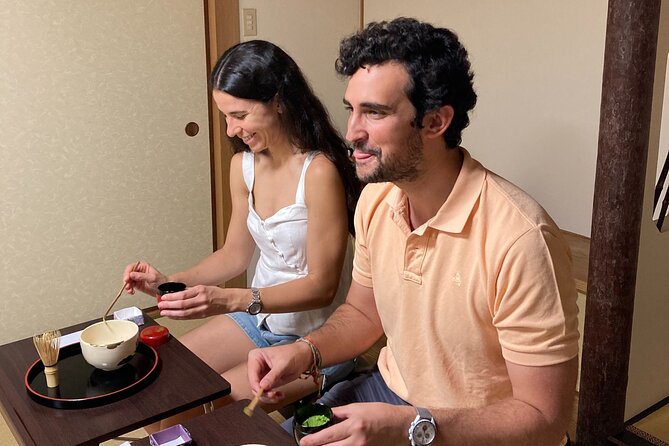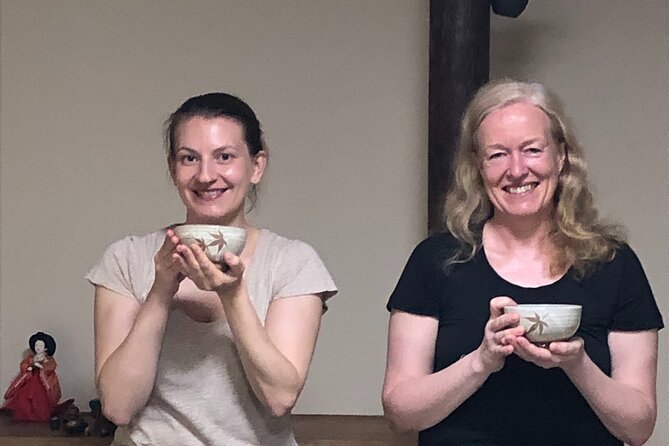Ever wondered about the intricate artistry behind the Japanese Tea Ceremony and Bon Ryaku Temae?
The theory that every gesture and movement in this tradition holds deep meaning and significance can truly captivate those willing to explore this ancient practice.
As the secrets of the tea ceremony unfold, one can’t help but be drawn into a world where every detail serves a purpose.
But what exactly lies behind each gesture and symbol?
The mystery behind the Bon Ryaku Temae awaits, promising a journey of discovery into the heart of Japanese culture and tradition.
Key Takeaways

- Tea ceremonies embody profound symbolism and Japanese values.
- Bon Ryaku Temae is a simplified yet culturally significant tea ceremony.
- Tray Style Ceremony in Hiroshima involves meticulous tea preparation.
- Following tea ceremony etiquette ensures a graceful and respectful experience.
Origins of Tea Ceremony

The origins of the Tea Ceremony can be traced back to ancient Japan, where it evolved as a cultural practice steeped in tradition and mindfulness. Rooted deeply in Japanese traditions, the Tea Ceremony holds significant cultural importance, emphasizing harmony, respect, purity, and tranquility.
This ceremonial practice isn’t merely about drinking tea but encompasses a holistic experience that reflects the core values of Japanese culture. Through meticulous rituals and etiquette, participants engage in a shared moment of connection, appreciation of beauty, and inner reflection.
The Tea Ceremony serves as a profound symbol of the Japanese way of life, promoting mindfulness, grace, and simplicity in a world often dominated by haste and complexity.
Meaning and Symbolism
Originating from ancient Japan, the Tea Ceremony embodies profound meanings and symbolic representations that resonate deeply within Japanese culture. Symbolism plays a crucial role in every aspect of the ceremony, from the selection of utensils to the preparation and serving of the tea. Each element, whether it’s the tea bowl, the bamboo whisk, or the design of the tea room, carries layers of cultural significance.
The act of preparing and sharing tea isn’t merely about the beverage itself but also about mindfulness, harmony, and respect. Through its symbolism, the Tea Ceremony serves as a reflection of Japanese aesthetics, values, and traditions, making it a cherished practice that continues to be passed down through generations.
Bon Ryaku Temae Overview
Introducing the streamlined Bon Ryaku Temae, a simplified version of the traditional tea ceremony practiced in Hiroshima, Japan. Bon Ryaku Temae holds significant cultural importance and has undergone modern adaptations to suit contemporary lifestyles. This style offers a unique blend of historical background and cultural immersion for participants.
Here are some key points about Bon Ryaku Temae:
- Emphasizes simplicity and efficiency
- Focuses on essential tea ceremony elements
- Provides a more accessible introduction to Japanese tea culture
- Allows for a quicker and more practical tea ceremony experience
- Showcases the beauty and elegance of tea rituals in a condensed form
Bon Ryaku Temae is a perfect choice for those seeking a taste of the tea ceremony tradition within a modern context.
Steps of Tray Style Ceremony
Explore the step-by-step process of the Tray Style Ceremony for a hands-on tea experience in Hiroshima, Japan. This cultural tradition involves meticulous tea preparation.
Firstly, the host purifies the utensils, followed by preparing the tea powder. Next, hot water is added to the tea bowl and whisked until frothy.
The host then serves the tea to the guests, who enjoy it in a prescribed manner. Each movement in this ceremony holds significance, reflecting the harmony and respect central to Japanese culture.
This immersive experience offers a glimpse into the rich heritage of tea ceremonies and the meticulous art of tea preparation. Embrace the elegance and tranquility of this ancient practice in the heart of Hiroshima.
Tea Ceremony Etiquette
Discover the essential etiquette guidelines to follow during a traditional Japanese tea ceremony in Hiroshima. Traditional customs hold significant cultural significance, guiding participants through a graceful and respectful experience. Here are some key etiquette rules to keep in mind:
-
Seiza Position: Sit on your knees with your back straight, showing respect.
-
Silence: Maintain a quiet atmosphere to appreciate the ritual fully.
-
Respect for Utensils: Handle the tea tools with care and reverence.
-
Accepting the Tea: Receive the bowl with both hands as a sign of gratitude.
-
Thanking the Host: Express appreciation to the host for their effort and hospitality.
Experience and Booking Details
After understanding the essential etiquette guidelines for a traditional Japanese tea ceremony in Hiroshima, it’s time to look into the experience and booking details available for participation in this cultural activity.
When booking, it’s essential to consider tea ceremony attire, typically consisting of clean and modest clothing. The history of the tea ceremony dates back to the 9th century and has deep cultural significance.
To secure a spot, visitors can reserve online, starting from $32.61 per person. The experience includes a coffee and/or tea meeting with a pickup at a designated location in Hiroshima. Participants will meet at 741-1 Miyajimachō, Hatsukaichi, Hiroshima 739-0588, Japan, and return to the same point after the ceremony. With a maximum of 8 travelers per session, reservations should be made in advance to ensure availability.
Frequently Asked Questions
Are There Any Specific Dress Code Requirements for Participating in the Tea Ceremony and Bon Ryaku Temae?
When attending a tea ceremony, it’s important to follow the dress code requirements for a respectful experience. Traditional attire like subdued colors and comfortable footwear is recommended to show appreciation for the ceremony’s cultural significance.
Can Participants Take Photographs or Videos During the Ceremony?
No, participants are not allowed to take photographs or videos during the ceremony, as it can disrupt the meditative atmosphere. Can participants sketch or draw the ceremony instead? It’s a respectful alternative to capture the experience.
Is There an Age Restriction for Participating in the Tea Ceremony?
There is no age restriction for participating in the tea ceremony. This traditional practice holds significant cultural value and welcomes participants of all ages to experience its rich history and customs firsthand.
Are There Any Dietary Restrictions or Considerations That Need to Be Communicated in Advance?
When it comes to dietary restrictions, communication in advance is crucial. Letting the organizers know about any special dietary needs ensures they can accommodate you properly. Remember to convey this information early for a smoother experience.
Is There a Specific Significance or Meaning Behind the Red Fan Sign Mentioned in the Directions to the Meeting Point?
The red fan sign mentioned in the directions to the meeting point symbolizes cultural traditions and Japanese symbolism. It holds historical significance and artistic expressions, guiding travelers to the tea ceremony experience in Hiroshima, Japan.
Conclusion
Overall, the Tea Ceremony and Bon Ryaku Temae in Hiroshima offer a unique and enlightening experience for those looking to delve into Japanese culture.
With expert guides and a maximum of 8 participants per session, this intimate setting allows for a personalized journey through the intricate rituals of preparing and presenting tea.
From the origins of the ceremony to the symbolism and etiquette involved, this excursion promises to be a memorable and enriching experience for all travelers.
